Messaging Records Management (MRM) and Retention Policies in Microsoft 365
Original KB number: 4032361
Summary
Microsoft 365 provides a default retention policy (also known as Default MRM Policy). To check for these policies in your environment, run the following cmdlet:
Get-RetentionPolicy | fl Name
For example, the output of this cmdlet resembles the following:
Name : Default MRM Policy
Name : Contoso-Default-Retention-Policy
To see which policy is set on a mailbox, run the following cmdlet:
Get-mailbox <SMTP> | fl RetentionPolicy
For example, the output of this cmdlet resembles the following:
RetentionPolicy: Contoso-Default-Retention-Policy
To change or set a retention policy for a user, run the following cmdlet:
Set-Mailbox <SMTP> -RetentionPolicy "Contoso-Default-Retention-Policy"
To view the retention policy tags that are associated with the plan, run the following cmdlet:
(Get-RetentionPolicy "Contoso-Default-Retention-Policy").RetentionPolicyTagLinks | Format-Table name
The output of this cmdlet resembles the following:
Name
----
1 Month Delete
1 Year Delete
3 Year Delete
6 Month Delete
Never Delete
Voice Mail Deletion
1 Week Archive
1 Month Archive
1 Year Archive
Never Archive
2 Year Archive
3 Month Archive
6 Month Archive
3 Year Archive
To view the details for a specific retention policy tag, run the following cmdlet:
Get-RetentionPolicyTag "1 Week Delete" | Format-list Name,Type,AgeLimitForRetention,MessageClass,RetentionAction
The output of this cmdlet resembles the following:
Name : 1 Week Delete
Type : Personal
AgeLimitForRetention : 7.00:00:00
MessageClass : *
RetentionAction : DeleteAndAllowRecovery
To view the details for all retention policy tag, run the following cmdlet:
Get-RetentionPolicyTag | Format-Table Name,Type,AgeLimitForRetention,MessageClass,RetentionAction
The output of this cmdlet resembles the following:
Name Type AgeLimitForRetention MessageClass RetentionAction
---- ---- -------------------- ------------ ---------------
1 Week Delete Personal 7.00:00:00 * DeleteAndAllowRecovery
1 Month Delete Personal 30.00:00:00 * DeleteAndAllowRecovery6 Month Delete Personal 180.00:00:00 * DeleteAndAllowRecovery1 Year Delete Personal 365.00:00:00 * DeleteAndAllowRecoveryNever Delete Personal * DeleteAndAllowRecovery ...
Troubleshooting
If a retention policy is not working as expected, review the following articles first to make sure that you understand how the policy processes items in your mailbox.
Issue: Items are not expiring as expected.
Issue: Managed Folder Assistant seems not to be processing my items.
Understanding of Managed Folder Assistant with retention policies
Note
If you must start the Managed Folder Assistant immediately, see Start-ManagedFolderAssistant.
Information about expiring contacts, calendar items, and tasks.
How to recover items that may have been processed by Managed Folder Assistant.
More Information
For end users
To view and apply retention policy tag in Outlook, right-click a folder, and then select the desired tag.
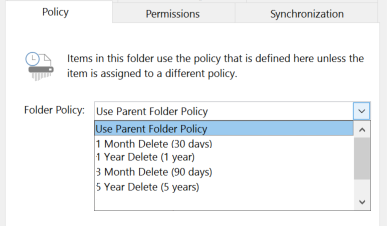
Depending on a user's Group Policy, they may be able to change this list (add/delete) through OWA under Options > Mail > Retention Policies.
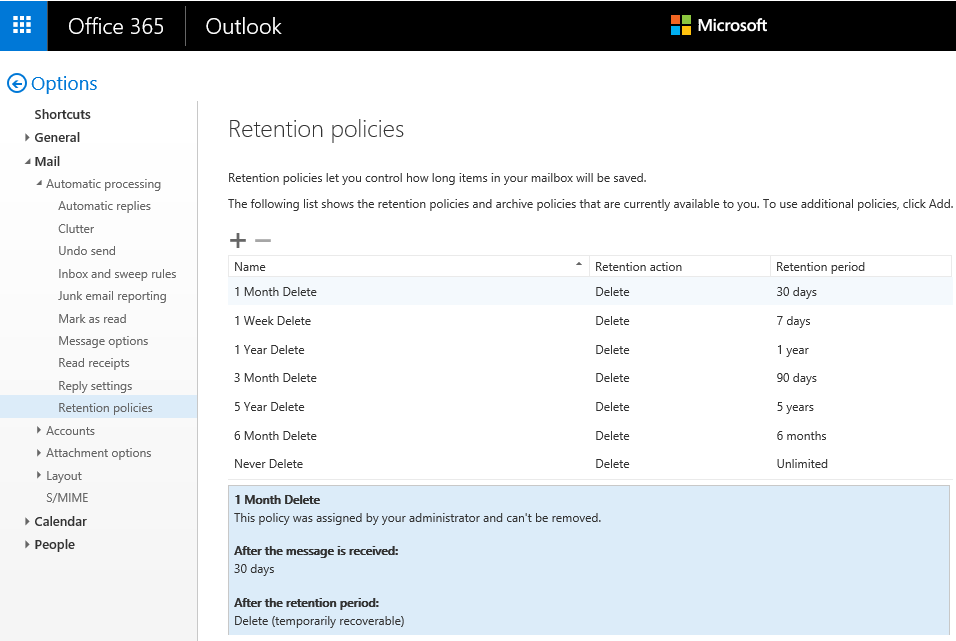
Check the retention policy option that applies to the folder in which the items are stored. To do this, right-click the folder, and then scroll down to Assign policy.
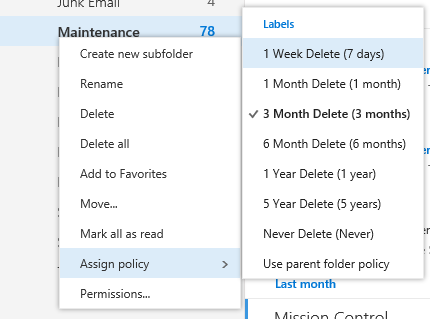
Check Retention Policy and Expire fields to see whether an item is set an expiration date.

Use the search bar to quickly find items that are set to expire. For example: "expires:<=the next month".
For more information, see Learn to narrow your search criteria for better searches in Outlook.
Use Customer Search Folder to do a more extensive search. To do this, under Advance setting, use the Expire field. For more information, see Create a Search Folder.
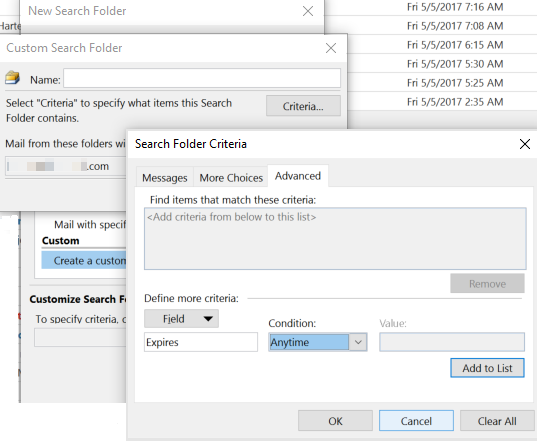
Set a specific expiration date. For detailed steps, see Set a message expiration date.
For administrators
Administrators can create new retention tags and policies by using the correct permission through the Exchange admin center (EAC) or PowerShell. For detailed steps, see Create a Retention Policy.
New Retention Tag
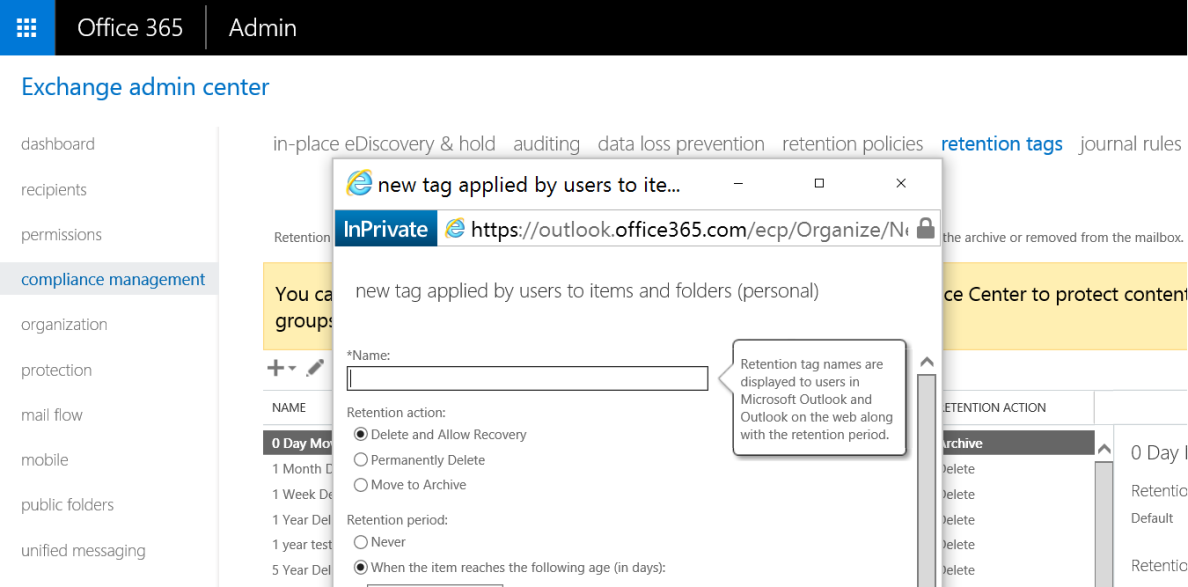
New Retention Policy (using new or existing tags)
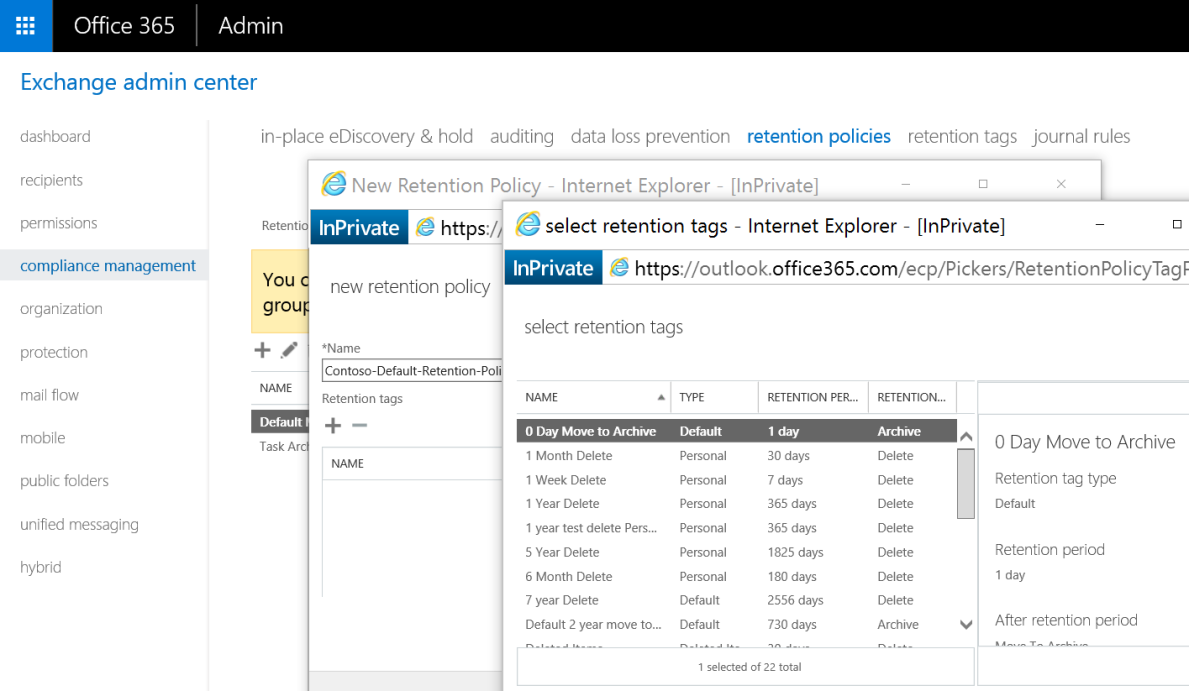
Retention tags are used to apply retention settings to messages and folders in user mailboxes. There are three types of retention tags:
- Default policy tag (DPT) is a retention tag that applies to all items in a mailbox that doesn't already have a retention tag applied. You can have only one DPT in a retention policy.
- Retention policy tag (RPT) is a retention tag that applies to default folders, such as Inbox and Deleted Items.
- Personal tag is used to make retention settings to custom folders and individual items, such as email messages. It's available to Outlook Web App, Outlook 2010, and later versions.
For more information, see the following articles:
- Messaging records management
- Messaging records management terminology
- Retention tags and retention policies
Help users recover missing message
Check whether an item was deleted, and then recover the item if it's necessary. To do this, see Recover deleted messages in a user's mailbox in Exchange Online.
Search and investigate missing items. To do this, see the following articles: